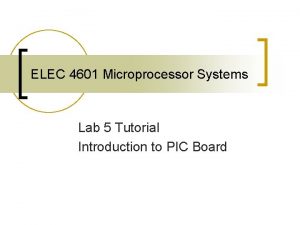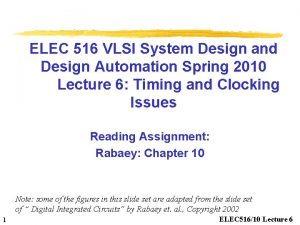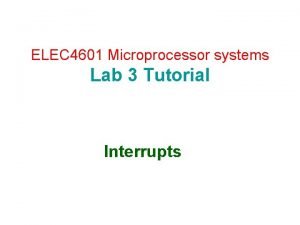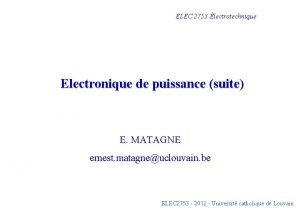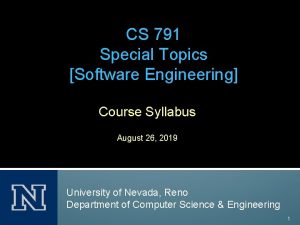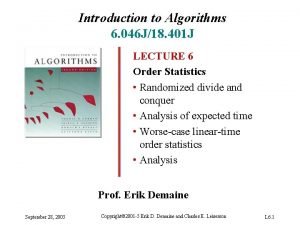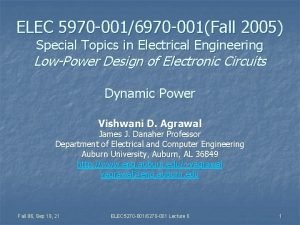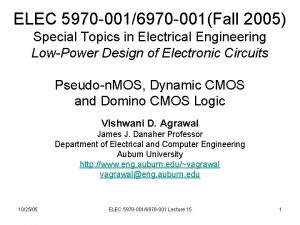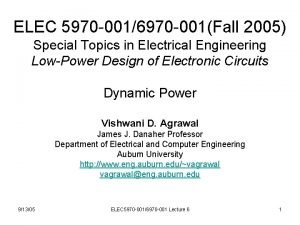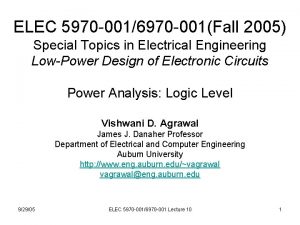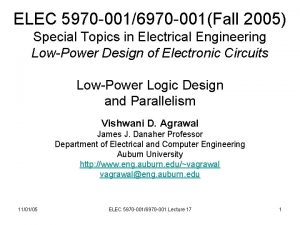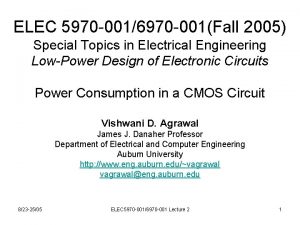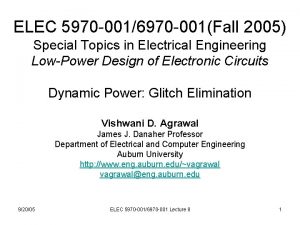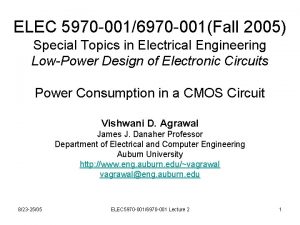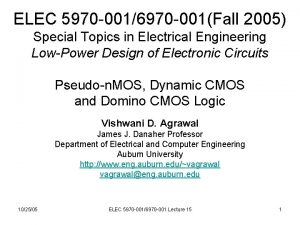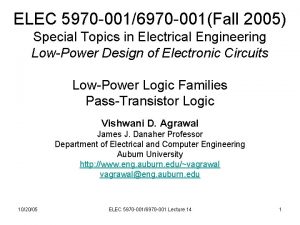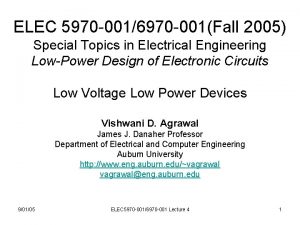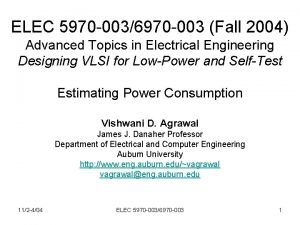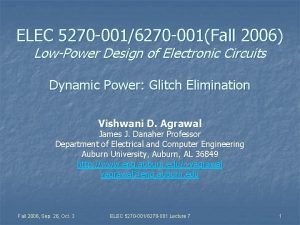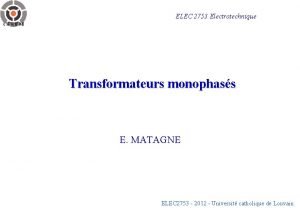ELEC 5970 0016970 001Fall 2005 Special Topics in


















- Slides: 18

ELEC 5970 -001/6970 -001(Fall 2005) Special Topics in Electrical Engineering Low-Power Design of Electronic Circuits Power Analysis: Logic Level Vishwani D. Agrawal James J. Danaher Professor Department of Electrical and Computer Engineering Auburn University http: //www. eng. auburn. edu/~vagrawal@eng. auburn. edu 9/29/05 ELEC 5970 -001/6970 -001 Lecture 10 1

Power Analysis • Motivation: – Specification – Optimization – Reliability • Applications – Design analysis and optimization – Physical design – Packaging – Test 9/29/05 ELEC 5970 -001/6970 -001 Lecture 10 2

Abstraction, Complexity, Accuracy Abstraction level Algorithm Computing resources Analysis accuracy Least Worst Most Best Software and system Hardware behavior Register transfer Logic Circuit Device 9/29/05 ELEC 5970 -001/6970 -001 Lecture 10 3

Spice • Circuit/device level analysis • Circuit modeled as network of transistors, capacitors, resistors and voltage/current sources. • Node current equations using Kirchhoff’s current law. • Average and instantaneous power computed from supply voltage and device current. • Analysis is accurate but expensive • Used to characterize parts of a larger circuit. • Original references: • L. W. Nagel and D. O. Pederson, “SPICE – Simulation Program With Integrated Circuit Emphasis, ” Memo ERL-M 382, EECS Dept. , University of California, Berkeley, Apr. 1973. • L. W. Nagel, SPICE 2, A Computer program to Simulate Semiconductor Circuits, Ph. D Dissertation, University of California, Berkeley, May 1975. 9/29/05 ELEC 5970 -001/6970 -001 Lecture 10 4

Logic Model of MOS Circuit p. MOS FETs a b VDD Ca Cc Cb n. MOS FETs Cd Ca , Cb , Cc and Cd are node capacitances 9/29/05 c a Da b Db c Dc Da and Db are interconnect or propagation delays Dc is inertial delay of gate ELEC 5970 -001/6970 -001 Lecture 10 5

Spice Characterization Input data pattern Delay (ps) Dynamic energy (p. J) a=b=0→ 1 69 1. 55 a = 1, b = 0 → 1 62 1. 67 a = 0 → 1, b = 1 50 1. 72 a=b=1→ 0 35 1. 82 a = 1, b = 1 → 0 76 1. 39 a = 1 → 0, b = 1 57 1. 94 9/29/05 ELEC 5970 -001/6970 -001 Lecture 10 6

Spice Characterization (Cont. ) 9/29/05 Input data pattern Static power (p. W) a=b=0 5. 05 a = 0, b = 1 13. 1 a = 1, b = 0 5. 10 a=b=1 28. 5 ELEC 5970 -001/6970 -001 Lecture 10 7

Switch-Level Partitioning • Circuit partitioned into channel-connected components for Spice characterization. • Reference: R. E. Bryant, “A Switch-Level Model and Simulator for MOS Digital Systems, ” IEEE Trans. Computers, vol. C-33, no. 2, pp. 160 -177, Feb. 1984. Internal switching nodes not seen by logic simulator 9/29/05 G 2 G 1 G 3 ELEC 5970 -001/6970 -001 Lecture 10 8

Delay and Discrete-Event Simulation (NAND gate) Transient region Inputs a b c (CMOS) Logic simulation c (zero delay) c (unit delay) X c (multiple delay) Unknown (X) c (minmax delay) 0 9/29/05 5 ELEC 5970 -001/6970 -001 Lecture 10 rise=5, fall=5 min =2, max =5 Time units 9

Event-Driven Simulation (Example) 2 e =1 g =1 2 2 d=0 4 b =1 f =0 Time stack a =1 c =1→ 0 t=0 1 2 3 4 5 6 7 8 Scheduled events Activity list c=0 d, e d = 1, e = 0 f, g g=0 f=1 g g=1 g 0 9/29/05 4 8 Time, t ELEC 5970 -001/6970 -001 Lecture 10 10

Time Wheel (Circular Stack) Current time pointer max t=0 1 Event link-list 2 3 4 5 6 7 9/29/05 ELEC 5970 -001/6970 -001 Lecture 10 11

Gate-Level Power Analysis • Pre-simulation analysis: – Partition circuit into channel connected gate components. – Determine node capacitances from layout analysis (accurate) or from wire-load model (approximate). – Determine dynamic and static power from Spice for each gate. – Determine gate delays using Spice or Elmore delay analysis. 9/29/05 ELEC 5970 -001/6970 -001 Lecture 10 12

Elmore Delay Model • W. Elmore, “The Transient Response of Damped Linear Networks with Particular Regard to Wideband Amplifiers, ” J. Appl. Phys. , vol. 19, no. 1, pp. 55 -63, Jan. 1948. 2 R 2 C 2 1 R 1 s 4 R 4 C 1 R 3 3 R 5 Shared resistance: C 3 R 45 = R 1 + R 3 5 R 15 = R 1 R 34 = R 1 + R 3 C 5 9/29/05 ELEC 5970 -001/6970 -001 Lecture 10 13

Elmore Delay Formula N Delay at node k = 0. 69 Σ Cj × Rjk j=1 where N = number of capacitive nodes in the network Example: Delay at node 5 = 0. 69[R 1 C 1 + R 1 C 2 + (R 1+R 3)C 3 + (R 1+R 3)C 4 (R 1+R 3+R 5)C 5] 9/29/05 ELEC 5970 -001/6970 -001 Lecture 10 14

Gate-Level Power Analysis (Cont. ) • Run discrete-event (event-driven) logic simulation with a set of input vectors. • Monitor the toggle count of each net and obtain capacitive power dissipation: Pcap = Σ Ck. V 2 f all nodes k – Where: • Ck is the total node capacitance being switched, as determined by the simulator. • V is the supply voltage. • f is the clock frequency, i. e. , the number of vectors applied per unit 9/29/05 ELEC 5970 -001/6970 -001 Lecture 10 15

Gate-Level Power Analysis (Cont. ) • Monitor dynamic energy events at the input of each gate and obtain internal switching power dissipation: Pint = Σ Σ E(g, e) f(g, e) gates g events e – Where • E(g, e) = energy of event e of gate g pre-computed from Spice. • F(g, e) = occurrence frequency of the event e at gate g observed by logic simulation. 9/29/05 ELEC 5970 -001/6970 -001 Lecture 10 16

Gate-Level Power Analysis (Cont. ) • Monitor the static power dissipation state of each gate and obtain the static power dissipation: Pstat = Σ Σ P(g, s) T(g, s)/ T gates g states s – Where • P(g, s) = static power dissipation of gate g for state s, obtained from Spice. • T(g, s) = duration of state s at gate g, obtained from logic simulation. • T = vector period. 9/29/05 ELEC 5970 -001/6970 -001 Lecture 10 17

Gate-Level Power Analysis (Cont. ) • Sum up all three components of power: P = Pstat + Pint + Pstat • References: • A. Deng, “Power Analysis for CMOS/Bi. CMOS Circuits, ” Proc. International Workshop Low Power Design, 1994. • J. Benkoski, A. C. Deng, C. X. Huang, S. Napper and J. Tuan, “Simulation Algorithms, Power Estimation and Diagnostics in Power. Mill, ” Proc. PATMOS, 1995. • C. X. Huang, B. Zhang, A. C. Deng and B. Swirski, “The Design and Implementation of Power. Mill, ” Proc. International Symp. Low Power Design, 1995, pp. 105 -109. 9/29/05 ELEC 5970 -001/6970 -001 Lecture 10 18
 Elec service plus
Elec service plus Elec
Elec Elec
Elec Elec 202
Elec 202 Elec 4601
Elec 4601 Dec alpha 21264
Dec alpha 21264 Elec 4601
Elec 4601 Elec
Elec Dena schlosser
Dena schlosser Software engineering course syllabus
Software engineering course syllabus Special investigative topics 3232 quizlet
Special investigative topics 3232 quizlet Moongiant 2005
Moongiant 2005 S/2005 j18
S/2005 j18 Rm 363 minsa 2005
Rm 363 minsa 2005 Clean neighbourhoods and environment act 2005 dog fouling
Clean neighbourhoods and environment act 2005 dog fouling 2005
2005 Regulatory reform fire safety order 2005 summary
Regulatory reform fire safety order 2005 summary On ne se moque pas de dieu
On ne se moque pas de dieu Visual studio 2005 team suite
Visual studio 2005 team suite




